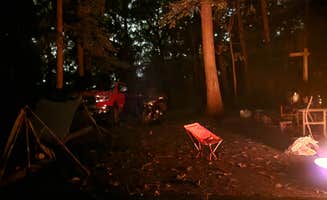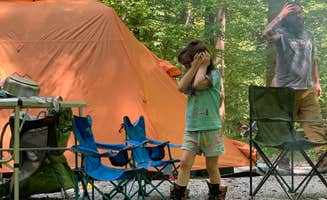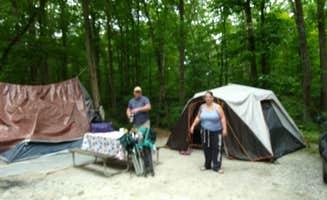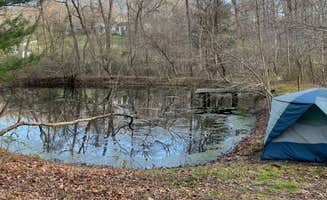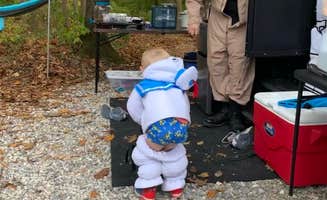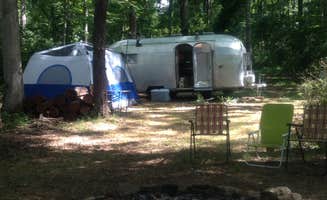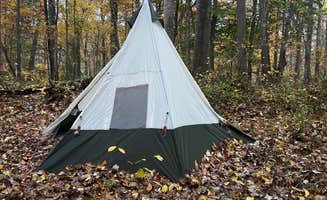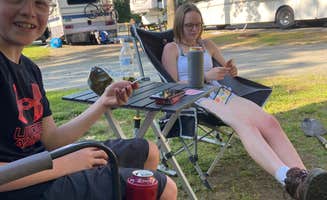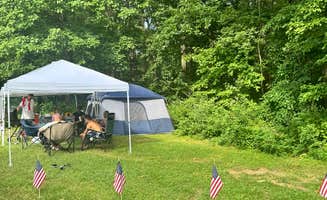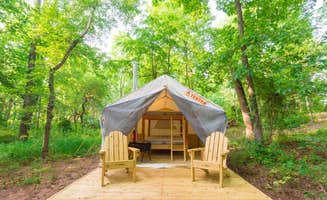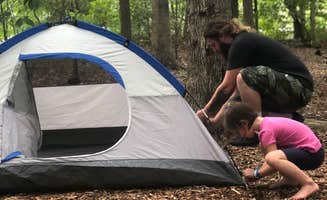Camping near Owings Mills, Maryland offers a mix of forested sites and full-service campgrounds within a 30-40 mile radius of Baltimore. The region sits in the Piedmont Plateau with elevations between 300-800 feet, creating varied terrain for campers. Winter temperatures typically range from 25-45°F, while summer months average 70-90°F with moderate humidity compared to coastal areas.
What to do
Fishing and boating access: At Ramblin' Pines in Woodbine, campers can enjoy on-site fishing. "There's a pond for fishing, a pool for swimming and a little general store for all your needs, the kids loved the bounce pillow," reports Michelle L. The campground provides multiple water-based activities without leaving the property.
Hiking trails: Many campgrounds connect directly to trail systems. At Hollofield Area Campground, Diana S. notes: "Took a fairly easy hike down to the river and even went for a swim. Loved it so much, I stopped on the way back home again!" These trails range from easy riverside paths to more challenging wooded routes.
DC sightseeing: Campgrounds serve as budget bases for Washington DC trips. "This is our local campground and our second time here and we really like it. It has a pool, jump pillow, mini golf, fishing pond, barnyard with goats, and multiple playgrounds," says Sean M. about Little Bennett Campground, highlighting activities available when not exploring the capital.
What campers like
Secluded sites despite urban proximity: Many campers appreciate finding wooded privacy near metropolitan areas. "You feel like you are truly secluded in the woods," wrote Ricky R. about Patapsco Valley State Park-Hilton Area, highlighting the contrast between the urban setting and natural camping experience.
Clean facilities: Patapsco Valley campgrounds maintain well-kept amenities. "Bathroom is clean and camp hosts are very friendly. Campsites are fairly close together but not right on top of each other," notes Michelle H. The bathhouses, while sometimes described as basic, receive consistent praise for cleanliness.
Diverse accommodation options: Several parks offer alternatives to traditional tent camping. Sean M. reports about Hilton Area: "The best part of this campground are the neat mini cabins. Small one room cabins that have electricity and heat. They are a nice touch for those that want to camp, but not completely 'rough it.'" These options extend camping seasons and attract different user groups.
What you should know
Seasonal operations and restrictions: Most state parks in the region operate camping from April through October. Rebecca C. advises: "The campground and park fill up on the weekends but are nearly empty during the week. There are several hiking trails in this part of the park or you can drive to other parts for additional hiking."
Varied site spacing: Campsite proximity differs between loops and campgrounds. Jennifer V. at Hollofield Area explains: "This campground is set up as two loops; an inner loop with electric sites, and a more spread-out outer loop with non-electric, tent-only sites. The inner loop was completely full, and the sites were just too closely spaced for my preferences."
Site surfaces and tent placement: Some campgrounds have specific requirements for tent setup. At Merry Meadows Recreation Farm, campers find a mix of "wooded sites, open sites, tent sites. All great!" according to Amy R. However, at Hollofield Area, crushed stone sites can make tent staking challenging.
Tips for camping with families
Kid-friendly amenities: Families benefit from dedicated children's areas. At Washington DC / Capitol KOA, Elise M. reports: "They have a nice area for kids (pool, playground, jumping pillow, basketball courts, giant chess, etc). If you get an area to back into it'll be more secluded, but the pull through spots offer no privacy."
Nature programs: Some parks offer educational activities. Angel G. notes about Patapsco Valley: "The Hilton entrance of Patapsco Valley Park is perfect for keeping the kids entertained. There is a huge playground, sensory trail and nature discovery center at the entrance to the park." These programs provide structured outdoor learning.
Playground access: Multiple campgrounds feature play areas. "There is a 'natural' playground in the loop, and then if you drive down further to the park entrance, there is a large playground for the kids," shares Jennifer S. about her experience at Hollofield Area, showing the different play options available.
Tips from RVers
Site selection strategies: Experienced RVers recommend researching specific sites. At Codorus State Park Campground, one camper advises: "There are some in wide-open park-like settings, and some that are treed. For the most part we didn't notice any that really seem to be right on top of each other."
Hookup considerations: Water and electric availability varies widely between campgrounds and specific loops. Ray & Terri F. detail: "We stayed at site D72 for 4 days. The sites are quiet, very spacious, level, and heavily wooded with 50A service, water and sewer hookup. D Loop is for RVs, A, B, C& E are tents only."
Access limitations: Some parks have restrictions that affect larger rigs. At Patapsco Valley State Park, one reviewer cautions: "APPROACH THIS PARK ONLY FROM THE WEST IF YOUR VEHICLE IS OVER 11 FEET HIGH. (There is a 11' bridge coming east bound into this park.)" This critical information prevents potentially dangerous situations.



